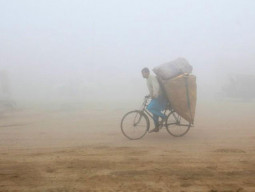
The conference was organised by the department in collaboration with the Higher Education Commission, USAID and the Centre for Advanced Infrastructure Technology, University of Mississippi (US).
Fifteen per cent of the increase has been the deaths of pedestrians, said the professor, explaining that the smooth, traffic signal-less roads may be good for zipping, speeding cars but the fact that there were hardly any pedestrian bridges meant that they have become a death trap for people on foot.
Another reason for the rise in accidents are vehicles going the wrong way because there are very few cuts for detours and U-turns, he said. Dr Ali felt that the corridors were speed-conducive and in a city where traffic rules are rarely enforced, speed can be quite deadly. “Around 45 per cent of road accidents in the city take place because of a lack of enforcement of traffic laws,” he said.
Before much-touted Corridor No. 1 was constructed, leading from Shahrae Faisal to SITE area, around 200 people were killed in accidents on that road, with 48 of them being pedestrians. Six months after the inauguration of the corridor, the death toll skyrocketed to 438, of which 110 were pedestrians.
“This means a 120 per cent increase in pedestrian incidents has been reported,” Dr Ali pointed out.
According to the programme manager of the Road Traffic Injury Research and Prevention Centre, Syed Akhtar Hussain, there has been an 11 per cent increase in road accidents in the city during the first quarter of 2010. He said that 266 people have lost their lives while 2,063 have been injured seriously.
In 2009, 31,000 cases were reported in which 1,200 people died and 6,500 were seriously injured. The most dangerous roads include Korangi Nadi, M A Jinnah Road, Old Quaidabad, Shahrae Faisal, Mauripur Road, Korangi Industrial Area, Northern Bypass, National Highway near Bhains Colony and Shershah Soori Road.
Rash driving, a lack of proper bus stops, unwary road crossing, motorcyclists without helmets and people breaking signals are the major causes of accidents, said Hussain.
“Most of the victims are motorcyclists. Around 17,000 bike riders were badly injured in 2009, out of which 400 succumbed to their injuries,” he said. He also pointed out that the areas where the most accidents take place are Baldia, Gadap, Korangi, Gulshan-e-Iqbal, Jamshed Town, Bin Qasim, SITE and Saddar.
The conference had included speakers from the US, Australia, Iran, New Zealand, Japan, India, the UK, Turkey and Nigeria.
Eight technical sessions were held and 29 research papers were presented and shared among the 200 participants, that included people from all walks of life.
At the concluding session on Sunday, participants and authors unanimously passed around 16 recommendations for better and safer traffic and city planning.
Published in The Express Tribune, July 5th, 2010.



1723032398-0/BeFunky-collage-(36)1723032398-0-165x106.webp)













COMMENTS (9)
Comments are moderated and generally will be posted if they are on-topic and not abusive.
For more information, please see our Comments FAQ